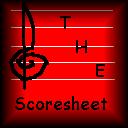The
A L I E N
Trilogy
by Jerry Goldsmith, James Horner, and Elliot Goldenthal
The Facts: This compilation was put out by Varese Sarabande in 1996.
It features suites from the first three Alien movies performed by the Royal
Scottish National Orchestra with Cliff Eidelman. Goldsmith’s portion
is about 22 minutes with Horner’s and Goldenthal’s each getting 15.
The excellent liner notes give a summary of the movies, information about
each track, as well as the story behind Goldsmith’s battle with Ridley
Scott over the use of his music. Scott basically butchered the score,
going as far a replacing the end credits with a portion of a 20th century
avant-garde symphony.
Review: This is a very good compilation that acts as a sampler
for the three scores. I originally had Aliens, but I no longer listen
to it very much , as this has nearly all of the good action music.
My favorite selections are from Alien, and I plan to order the full album
eventually. This part also has some previously unreleased music.
Goldenthal’s Alien3 is by far the weakest, and although some people love
this score, I’m just going to stay with the suite on here.
Track by Track Analysis:
Alien:
1. Main Title (3:16)
Goldsmith wrote two main titles, both opposites of each other.
The alternate, which Goldsmith preferred, was put on the OST, and it supposedly
is melodious and majestic. This CD presents for the first time the
film version of the main title. This is much more dissonant and menacing
than the original.
2. Hypersleep (2:45)
Introduces a repeated four-note woodwind motif that Horner would later
utilize in the sequel. Fragments of the main theme appear in the
strings. This is a previously unreleased track.
3. The Landing (4:33)
As the Nostromo lands on the alien planet, Goldsmith puts his rejected
main theme through a number of interesting permutations. He weaves
the motif from the last track into the lonely, desolate main theme.
This cue, as well as the end titles remind me of parts of Star Trek: The
Motion Picture. This is one of my two favorite parts in the suite.
Sadly, Ridley Scott totally killed this cue in the film and replaced it
with sound effects.
4. Breakaway (3:11)
Another unused track. It begins with savage horn and brass passages
with a grunting, exotic instrument. Then the action motif comes in.
It is played over and over until it exhausts itself. Be careful,
as I have had this segment run around in my head for days after listening
to it. Following the completion of the action music is a minute of
tranquillity with the Time motif.
5. The Droid (3:46)
Probably the most dissonant track on the album, this introduces many
avant-garde techniques common to Goldsmith score of the 60’s and 70’s.
Not for the squeamish or people who despise atonal music.
6. The Door (1:28)
This is a counterpoint to Breakaway and combines some of the motifs
with the main theme.
7. End Title (3:27)
This fully develops Goldsmith’s unused main theme. As I said
above, there are hints of his ST:TMP score in here. The suite ends
with a nice cadence. The highlight of the album.
Aliens
8. Main Title (6:21)
Horner’s dissonant action score begins with an atonal part, followed
by his theme. It sounds good, but it was lifted almost verbatim from
Aram Khachaturian’s Gayane Ballet Suite. This track also uses Goldsmith’s
Time motif, this time with echoing trumpets instead of woodwinds.
9. Futile Escape (5:45)
An exciting action track. This uses an action motif from Star
Trek 2 (found in nearly every score I have by him, including Rocketeer,
Krull, Titanic, etc.) with frenetic accompaniment. A great effect
is achieved when he uses the normally calm main theme with the violent
music. Later in the track, Star Trek 3’s Klingon motif appears, and
the three sections converge to a brutal climax. My only complaint
is that it’s played much slower than the original.
10. Bishop’s Countdown (3:21)
This (I think) completely original cue has been used almost every action
movie trailer since 1987. It is complete atonal, except for the last
minute, and has the clanging percussion used in the last track, except
more frantic. The ending provides an excellent climax to the suite.
Things settle down finally, as the rest of the track is a tranquil resolution
of the previous material.
Alien3
11. Lento (5:23)
Elliot Goldenthal’s section begins with a surprisingly melodic boy
soprano solo singing a setting of both Agnus Dei and Dona Nobis Pacem from
the Catholic Mass. There is next an impressionistic string and horn
fanfare, which sounds like the “sequel” to a section of Bishop’s Countdown
(the string arpeggios.) I think it provides a nice continuity between
the otherwise different scores. An instrumental reprise of the vocal
material followed by a minute of foreboding music ends the track.
12. Candles in the Wind (4:16)
Demonstrates Elliot Goldenthal's 20th Century avant-garde sensibilities
with striking glissandi.
13. Adagio (4:15)
A touching, triumphant theme emerges as Ripley jumps to her death.
All in all this is a great compilation, unless you can’t stand remotely
dissonant music. Even then, there are still some great melodic parts.
Alien Trilogy: The Final Score
| Music Rating |
8.5/10 |
|
|
| Packaging/Liner Notes |
10/10 |
| Orchestral Performance |
7/10 |
| Selection of Music |
9/10 |
| Running Time |
8/10 |

| Reviews
by Title | Reviews
by Composer | Links
Page | ScoreSheet
Home |
The Alien Trilogy is Copyright 1996 by Varese Sarabande. Its appearance
on this site is for nonprofit, informational use and does not intend to
infringe copyright.
This review is Copyright 1999 by Andrew Drannon. These opinions are
my own and do not reflect those of Tripod or any other parties.